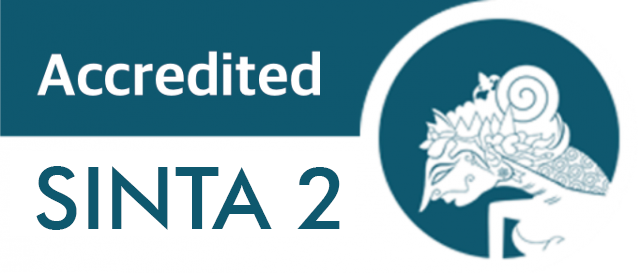FRAMEWORK FOR INVESTING INDONESIAN EFL LISTENING MATERIALS WITH CHARACTER EDUCATION
DOI:
https://doi.org/10.15408/tjems.v4i2.6197Keywords:
Listening, character education, folklore, intercultural understanding, 21st-century language competenceAbstract
Abstract
This paper offers a solution to Indonesia’s mission of investing EFL listening materials with character education in higher institutions. The character is seen as a dimension of content competence, namely attitude. Developed by using Content-Based Instruction approach, the alternative view is reflected through listening materials design to target strengthening moral values, principles, and attitudes. The framework argues that listening materials should accommodate the need to tailor materials for teaching, rather, than for assessment. It also responds to the ubiquity of English as a Lingua Franca. It argues that the investment of character education leads to learning targets that allow students to become concerned, informed, and involved in developing themselves as citizens, and to respond to 21st-century language competences, especially in the ability to embrace cross-cultural understanding and in the use of digital technology in classroom language learning. The proposed framework is offered as decisions made on the materials’ resources, method of development, activities, and assessment.
Abstrak
Artikel ini menawarkan solusi terhadap misi Indonesia untuk berinvestasi pendidikan karakter di dalam materi ajar Listening untuk pembelajaran di pendidikan tinggi (universitas). Karakter dimaknai sebagai kompetensi isi yaitu perilaku. Rancangan materi ini dikembangkan dengan menggunakan pendekatan berbasis isi (Content-Based Instruction). Kerangka rancangan alternatif ini bertujuan untuk menguatkan nilai-nilai moral, prinsip, dan perilaku. Dengan kerangka berfikir bahwa materi Listening seharusnya dibuat untuk tujuan belajar (learning) daripada untuk asesmen semata-mata, maka materi ajar harus mengakomodasi pola ini. Rancangan materi ini juga merespon kehadiran perspektif English as a Lingua Franca. Hal ini bermakna bahwa investasi pendidikan karakter hendaknya bermuara pada tujuan-tujuan pembelajaran yang menciptakan pembelajar menjadi pribadi yang perhatian, cakap pengetahuan, dan partisipatif dalam mengembangkan dirinya sebagai warga negara. Selain itu rancangan materi ini juga merespon pentingnya tercapainya kompetensi berbahasa abad ke -21 khususnya kemampuan pemahaman lintas budaya dan penggunaan teknologi digital untuk keperluan pembelajaran di dalam kelas. Kerangka rancangan materi ini tercermin pada pemilihan sumber materi, metode pengembangan materi, aktifitas, serta asesmen.
How to Cite : Kusumaningputri, R., Khazanah, D., Setiarini, R. (2017). Framework for Investing Indonesian EFL Listening Materials with Character Education. TARBIYA: Journal of Education in Muslim Society, 4(2), 184-199. doi:10.15408/tjems.v4i2.6197.
Permalink/DOI: http://dx.doi.org/10.15408/tjems.v4i2.6197
References
Author, et.al. (2016). Pedagogical tasks reflected in materials for shaping EFL college students’ intercultural citizenship in listening classrooms. In Creativity and Innovation in Language Materials Development and Language Teaching Methodology in Asia And Beyond, 8-10 September 2016 (pp. 776-784). Surabaya: University Press Adi Buana Surabaya.
Author, et. al. (2017). Listening for character education. Diandra Kreatif: Yogyakarta.
Almerico, G. M. (2014). Building character through literacy with children’s literature. Research in Higher Education Journal, 26, 1-13. Retrieved from http://www.aabri.com/manuscripts/141989.pdf
Alptekin, C. (2002). Towards intercultural communicative competence in ELT. ELT Journal, 56 (1), 57-64. doi: 10.1093/elt/56.1.5.
Brown, H. D. (2004). Language Assessment Principles and Classroom Practices. Pearson Education: New York.
Brown, J. D. (2014). The Future of World Englishes in Language Testing, Language Assessment Quarterly, 11(1), 5-26.
Brown, J. D., Salmani Nodoushan, M. A. (2015). Language Testing: The State of the Art (An online interview with James Dean Brown). International Journal of Language Studies, 9(4), 133-143.
Chang, C-S., Wu, Wen-Pin., Pang, C-LC. (2013). Second language listening difficulties perceived by low-level learners. Perceptual & Motor Skills: Learning & Memory, 116(2), 415-434.
Cox, C, B. (2014). 21st Century Skills and Principles of Flow in the Foreign Language Classroom. (2014). All Theses and dissertations Paper 4197. Retrieved from http://scholarsarchive.byu.edu/cgi/viewcontent.cgi?article=5196&context=etd
Danandjaya, J. (1995). A comparative study of Japanese and Indonesian Folklores. Southeast Asian Studies 33(3), 202-2014. Retrieved from https://kyoto-seas.org/pdf/33/3/330310.pdf
Desain Induk Pendidikan Karakter [DIPK/Blueprint of Character Education]. (2010). Jakarta: Kementerian Pendidikan Nasional [National Education Ministry].
Dharmawan, N. S. (2014). Implementasi pendidikan karakter bangsa pada mahasiswa di perguruan tinggi. Paper presented in Pembinaan Pendidikan Karakter bagi Mahasiswa PTS di Lingkungan Kopertis Wilayah VIII Tahun 2014. Retrieved from http://www.fkh.unud.ac.id/ind/wp-content/uploads/2014/01/Pnddkn-Karakter-Bngs-NS-Dharmawan-2014.pdf
Djiwandono, P. (2016). Character education in content courses: self-scoring as a means for developing honesty in students. Teflin Journal 27(2), 153-165. Retrieved from http://journal.teflin.org/index.php/journal/article/view/329/268
Ellis R. (2008). The Study of Second Language Acquisition. Oxford: Oxford University Press.
Field, J. (2010). The changing face of listening. In Richards, J.C & Renandya, W. (Eds), Methodology in Language Teaching: An anthology of current practice (pp. 242-247). Cambridge: Cambridge University Press.
Goodfellow, J. (2012). Looking, Listening-in, and meaning making; an infant’s encounters at meaning making. Early Childhood Folio, 16(1), 22-26.
Galloway, N., Rose, H. (2014).Using listening journals to raise awareness of Global Englishes in ELT. ELT Journal, 68(4), 386-396. doi: 10.1093/elt/ccu021
Graddol, D. (2006). English Next: Why global English may mean the end of ‘English as a Foreign Language’. British Council: UK.
Hasanah. (2013). Implementasi Nilai-Nilai Karakter Inti Di Perguruan Tinggi. (The implementation of Core values of Characters in Higher Education). Jurnal Pendidikan Karakter III, No.2. Retrieved from: http://pbi.fkip.untad.ac.id/wp-content/uploads/2014/09/Language-Learning-and-Teacher-Education.pdf#page=23
Hinkel E. (1996). When in Rome: Evaluations of L2 pragmalinguistic behaviour’. Journal of Pragmatics, 26(1): 51-70. doi 10.1016/0378-2166/(95)00043-7
House, J. (2003). English as a lingua franca: A threat to multilingualism. Journal of Sociolinguistics. 7(4), 556-578.
Jenkins, J. (2012). English as a Lingua Franca from the classroom to the classroom. E LT Journal 66(4), 486-494.
Kirkpatrick, A. (2007). World Englishes: Implications for international communication and English language teaching. Cambridge. University Press.
Kramsch, C. (1993). Context and Culture in Language Teaching. Oxford: Oxford University Press.
Kuh, G.D., Umbach, P.D. (2004). College and Character: Insights from the National Survey of Student . New Direction for Institutional Research, 122, 37-54. Retrieved from file:///C:/Users/AOD/Downloads/Kuh,%20Umbach%20%282004%29%20College%20and%20Character.pdf
Lee, G. L. (2011). Best practices of teaching traditional beliefs using Korean folk literature
Lickona, T. (1991). Educating for character: How our schools can teach respect and responsibility. New York, NY: Bantam Books.
Luchini, P. L., Arguello, M. (2009). Listening skill teaching: Some pedagogical considerations . Iranian Journal of Language Studies (IJLS), 3(3), 317-344. Retrieved from https://www.academia.edu/20302877/Volume_3_Number_3_Upload_Date_01_February_2016_
Mambu, J. E. (2015). Challenges in asessing character education in ELT: Implications from a case study in a christian university. TEFLIN Journal , 26(2), 183-208.
Masuhara, H., Hann, N., Yi, Y., Tomlinson, B.(2008). Adult EFL courses. ELT Journal , 62(3): 294-312. doi 10.1093/elt/ccno28
Matsuda, A. (2002). Representation of users and uses of English in beginning Japanese EFL textbooks. JALT Journal, 24(2), 182-201.
McKay, S, L. (2003). Toward an appropriate EIL pedagogy: re-examining common ELT assumptions. International Journal of Applied Linguistics, 13(1), 1-22. Retrieved from http://www.ugr.es/~isanz/archivos_m3thodology/articuloELIPEDAGOGY.pdf
Muriel-Saville, Troike. (2006). Introducing Second Language Acquisition. Cambridge: UK.
Norton, B. (1997). Language, Identity, and the ownership of English. TESOL Quartely 31(3), 409-429.
Novianti, N. (2017). Bildungsroman for character education in higher education: An Indonesian context. International Journal of Education, 9(2), 126-132 doi: dx.doi.org/10.17509/ije.v9i2.5474
Panduan Pelaksanaan Pendidikan Karakter [Guidelines for Implementing Character Education]. (2011). Jakarta: Kementerian Pendidikan Nasional [National Education Ministry].
Qoyyimah, U. (2015). EFL teachers’ professional dilemmas with moral curriculum reform in Indonesia. Unpublished doctoral thesis. Retrieved from http://eprints.qut.edu.au/83676/1/Uswatun_Qoyyimah_Thesis.pdf
Renandya, W.T. (2011). Extensive listening in the language classroom. In H.P Widodo & A.Cirocki (Eds). Innovation and creativity in ELT methodology, 28-41. New York: Nova Science Publisher
Renandya, W, T., Farrel, T, S.C. (2011). ‘Teacher, the tape is too fast!’ Extensive listening in ELT. ELT Journal, 65(1), 52-59.
Richards, J.C. (2005). Materials development and research. Making the connection. Paper presented at a colloquium on research and materials development at the TESOL Convention, San Antonio.
Robin, B. R. (2008). Digital Storytelling: A powerful technology tool for 21st century classroom. Theory Into Practice 47, 220-228. Retrieved from http://digitalstorytellingclass.pbworks.com/f/Digital%2520Storytelling%2520A%2520Powerful.pdf
Seidlhofer, B. (2004). Research perspective on Teaching English as a Lingua Franca. Annual Review of Applied Linguistics, 24, 209–239. Cambridge: Cambridge University Press.
Shabaan, K. (2005) A Proposed Framework for Incorporating Moral Education into the ESL/EFL Classroom. Language, Culture And Curriculum, 18(2), 201-217. Retrieved from http://citeseerx.ist.psu.edu/viewdoc/download?doi=10.1.1.502.5363&rep=rep1&type=pdf
Sherman, John Eric. (2010). Uncovering Cultural Bias in EFL Textbooks. Issues in Applied Linguistics, 18(1), 27-53. Retrieved from: http://escholarship.org/uc/item/4rc558zw
Siegal M (1996) The role of learner subjectivity in second language sociolinguistic competency: Western women learning Japanese. Applied Linguistics, 17(3), 356-382.
Stephens, M. (2011). The primacy of extensive listening. ELT Journal, 65(3), 311-313.
Stoller, F. (2002, March). Content-Based Instruction: A Shell for Language Teaching or a Framework for Strategic Language and Content Learning? Keynote presented at the annual meeting of Teachers of English to Speakers of Other Languages, Salt Lake City. (full transcript available at the CoBaLTT website).
Tomlinson, B., Dat, B., Masuhara, H., Rubdy, R. (2001). EFL courses for adults. ELT Journal, 55(1), 80-101.
Tomlinson, B. (2011). Glossary of basic terms for materials development in language teaching. In Materials Development in Language Teaching, Second Edition. Retrieved from file:///C:/Users/AOD/Downloads/materials-development-in-language-teaching2-hardback-frontmatter.pdf
Ur, P. (2009). English as a Lingua Franca and Some Implications for English Teachers. Retrieved from http://www.tesol-france.org/Colloquium09/Ur_Plenary_Handouts.pdf
Widodo, H. P. (2015). The Development of Vocational English Materials from a Social Semiotic Perspective: Participatory Action Research. Unpublished doctoral dissertation, University of Adelaide, Australia
Woodall, B. (2010) Simultaneous Listening and Reading in ESL: Helping Second Language Learners Read (and Enjoy Reading) More Efficiently. TESOL journal, 1(2), 186-205.
Wovin, A.D. (Ed). (2010). Listening and Human Communication in 21st century. Sussex: Wiley-Blacwell.
Yang, Ya-Ting C., Wu, Wan-Chi I. (2012). Digital storytelling for enhancing student academic achievement, critical thinking, and learning motivation: A year-long experimental study. Computers & Education, 59(2), 339–352. Retrieved from https://pdfs.semanticscholar.org/9931/8520693c388f23adca526d2cbe4cac001906.pdf.











